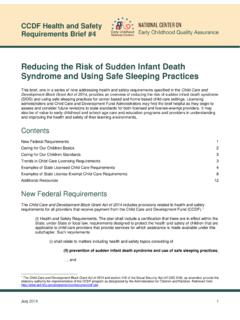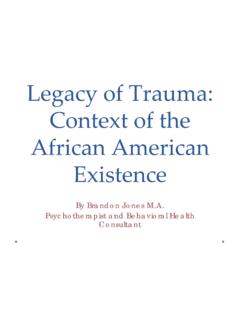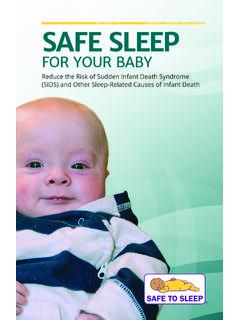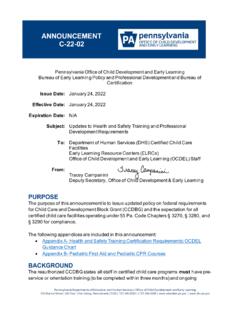Transcription of Mortality in the United States, 2017
1 NCHS Data Brief No. 328 November DEPARTMENT OF HEALTH AND HUMAN SERVICESC enters for Disease Control and PreventionNational Center for Health StatisticsMortality in the United States, 2017 Sherry L. Murphy, , Jiaquan Xu, , Kenneth D. Kochanek, , and Elizabeth Arias, findingsData from the National Vital Statistics System Life expectancy for the population declined to years in 2017. The age-adjusted death rate increased by from deaths per 100,000 standard population in 2016 to in 2017. Age-specific death rates increased from 2016 to 2017 for age groups 25 34, 35 44, and 85 and over, and decreased for the age group 45 54. The 10 leading causes of death in 2017 remained the same as in 2016. The infant Mortality rate of infant deaths per 100,000 live births in 2017 was not significantly different from the 2016 rate. The 10 leading causes of infant death in 2017 remained the same as in 2016 although 4 causes changed report presents final 2017 Mortality data on deaths and death rates by demographic and medical characteristics.
2 These data provide information on Mortality patterns among residents by variables such as sex, race and ethnicity, and cause of death . Life expectancy estimates, age-specific death rates, age-adjusted death rates by race and ethnicity and sex, 10 leading causes of death , and 10 leading causes of infant death were analyzed by comparing 2017 and 2016 final data (1).How long can we expect to live?In 2017, life expectancy at birth was years for the total population a decrease from years in 2016 (Figure 1). For males, life expectancy changed from in 2016 to in 2017. For females, life expectancy remained the same at age 65At birthMaleBoth sexesFemaleMaleBoth sexesLife expectancy (years)20162017 Figure 1. Life expectancy at selected ages, by sex: United States, 2016 and 2017 NOTES: Life expectancies for 2016 were revised using updated Medicare data; therefore, figures may differ from those previously published. Access data table for Figure 1 at: #1. SOURCE: NCHS, National Vital Statistics System, Data Brief No.
3 328 November 2018 2 Life expectancy for females was consistently higher than it was for males. In 2017, the difference in life expectancy between females and males increased year from years in 2016 to years in 2017, life expectancy at age 65 for the total population was years, an increase of year from 2016. Life expectancy at age 65 was years for females and years for males, both unchanged from 2016. The difference in life expectancy at age 65 between females and males was years, unchanged from are the age-adjusted death rates for race ethnicity sex groups?The age-adjusted death rate for the total population increased from per 100,000 standard population in 2016 to in 2017 (Figure 2). Age-adjusted death rates increased in 2017 from 2016 for non-Hispanic white males ( ) and non-Hispanic white females ( ). The age-adjusted death rate decreased for non-Hispanic black females ( ). Rates did not change significantly for non-Hispanic black males, Hispanic males, and Hispanic females from 2016 to 2.
4 Age-adjusted death rates, by race and ethnicity and sex: United States, 2016 and 2017 1 Statistically significant increase in age-adjusted death rate from 2016 to 2017 (p < ).2 Statistically significant decrease in age-adjusted death rate from 2016 to 2017 (p < ).NOTE: Access data table for Figure 2 at: # : NCHS, National Vital Statistics System, ,2001,000800600400200 Non-Hispanicblack maleNon-Hispanicwhite maleNon-Hispanicblack femaleNon-Hispanicwhite , , per 100,000 standard populationNCHS Data Brief No. 328 November 2018 3 Did age-specific death rates change among those aged 15 years and over? death rates increased significantly between 2016 and 2017 for age groups 25 34 ( ), 35 44 ( ), and 85 and over ( ) (Figure 3).The death rate decreased significantly for age group 45 54 ( ).Rates for other age groups did not change significantly between 2016 and 3. death rates for ages 15 years and over: United States, 2016 and 2017 1 Statistically significant increase in age-specific death rate from 2016 to 2017 (p < ).
5 2 Statistically significant decrease in age-specific death rate from 2016 to 2017 (p < ).NOTES: Rates are plotted on a logarithmic scale. Access data table for Figure 3 at: # : NCHS, National Vital Statistics System, ,00010, 641, , 744, , 8413, , and over1,000100101 Age group (years)20162017 Deaths per 100,000 populationNCHS Data Brief No. 328 November 2018 4 What are the leading causes of death ?In 2017, the 10 leading causes of death (heart disease, cancer, unintentional injuries, chronic lower respiratory diseases, stroke, Alzheimer disease, diabetes, influenza and pneumonia, kidney disease, and suicide) remained the same as in 2016. Causes of death are ranked according to number of deaths (1). The 10 leading causes accounted for of all deaths in the United States in 2016 to 2017, age-adjusted death rates increased for 7 of 10 leading causes of death and decreased for 1 (Figure 4 ). The rate increased for unintentional injuries, for chronic lower respiratory diseases, for stroke, for Alzheimer disease, for diabetes, for influenza and pneumonia, and for suicide.
6 The rate decreased for cancer. Rates for heart disease and kidney disease did not change 4. Age-adjusted death rates for the 10 leading causes of death : United States, 2016 and 2017 Deaths per 100,000 standard population1 Statistically significant decrease in age-adjusted death rate from 2016 to 2017 (p < ).2 Statistically significant increase in age-adjusted death rate from 2016 to 2017 (p < ).NOTES: A total of 2,813,503 resident deaths were registered in the United States in 2017. The 10 leading causes accounted for of all deaths in the United States in 2017. Causes of death are ranked according to number of deaths. Rankings for 2016 data are not shown. Data table for Figure 4 includes the number of deaths for leading causes. Access data table for Figure 4 at: # : NCHS, National Vital Statistics System, lower respiratory and Data Brief No. 328 November 2018 5 What are the leading causes of infant death ?The infant Mortality rate (IMR) the ratio of infant deaths to live births in a given year is generally regarded as a good indicator of the overall health of a population.
7 IMR changed from infant deaths per 100,000 live births in 2016 to in 2017, but this change was not statistically 10 leading causes of infant death in 2017 accounted for of all infant deaths in the United States. The leading causes remained the same as in 2016 although maternal complications became the third leading cause while sudden infant death syndrome became the fourth, and diseases of the circulatory system became the eighth leading cause while respiratory distress of newborn became the ninth (Figure 5). Causes of infant death are ranked according to number of infant deaths (1). IMR for unintentional injuries increased from infant deaths per 100,000 live births in 2016 to in 2017. Mortality rates for other leading causes of infant death did not change 5. infant Mortality rates for the 10 leading causes of infant death in 2017: United States, 2016 and 2017 infant deaths per 100,000 live births1 Statistically significant increase in Mortality rate from 2016 to 2017 (p < ).
8 NOTES: A total of 22,335 deaths occurred in children under age 1 year in the United States in 2017, with an infant Mortality rate of infant deaths per 100,000 live births. The 10 leading causes of infant death in 2017 accounted for of all infant deaths in the United States. A total of 23,161 infant deaths occurred in 2016, with an infant Mortality rate of infant deaths per 100,000 live births. Causes of death are ranked according to number of deaths. Rankings for 2016 data are not shown. Data table for Figure 5 includes the number of deaths under age 1 year for leading causes of infant death . Access data table for Figure 5 at: # : NCHS, National Vital Statistics System, infant death and placental birth sepsis of of the circulatory distress of Data Brief No. 328 November 2018 6 SummaryIn 2017, a total of 2,813,503 resident deaths were registered in the United States 69,255 more deaths than in 2016. From 2016 to 2017, the age-adjusted death rate for the total population increased , and life expectancy at birth decreased year.
9 Age-specific death rates between 2016 and 2017 increased for age groups 25 34, 35 44, and 85 and over, and decreased for age group 45 54. Age-adjusted death rates increased for non-Hispanic white males and non-Hispanic white females and decreased for non-Hispanic black 10 leading causes of death in 2017 remained the same as in 2016. Age-adjusted death rates increased for seven leading causes and decreased for one. Life expectancy at birth decreased year from years in 2016 to in 2017, largely because of increases in Mortality from unintentional injuries, suicide, diabetes, and influenza and pneumonia, with unintentional injuries making the largest 2017, a total of 22,335 deaths occurred among children under age 1 year, which was 826 fewer infant deaths than in 2016. The leading causes of infant death were the same in 2017 and 2016 although maternal complications became the third leading cause while sudden infant death syndrome became the fourth, and diseases of the circulatory system became the eighth leading cause while respiratory distress of newborn became the ninth.
10 The only significant change among the 10 leading causes of infant death was a increase in IMR for unintentional of death : Based on medical information including injury diagnoses and external causes of injury entered on death certificates filed in the United States. This information is classified and coded in accordance with the International Statistical Classification of Diseases and Related Health Problems, Tenth Revision (2). death rates: For 2017, based on population estimates for July 1, 2017, that are consistent with the April 1, 2010, census. These population estimates (as well as population figures for the 2010 census) are available on the National Center for Health Statistics (NCHS) website (3). Age-adjusted death rates are useful when comparing different populations because they remove the potential bias that can occur when the populations being compared have different age structures. NCHS uses the direct method of standardization; see Technical Notes of Deaths: Final Data for 2016 (1) for more Mortality rate (IMR): Computed by dividing the number of infant deaths in a calendar year by the number of live births registered for that same time period.

















